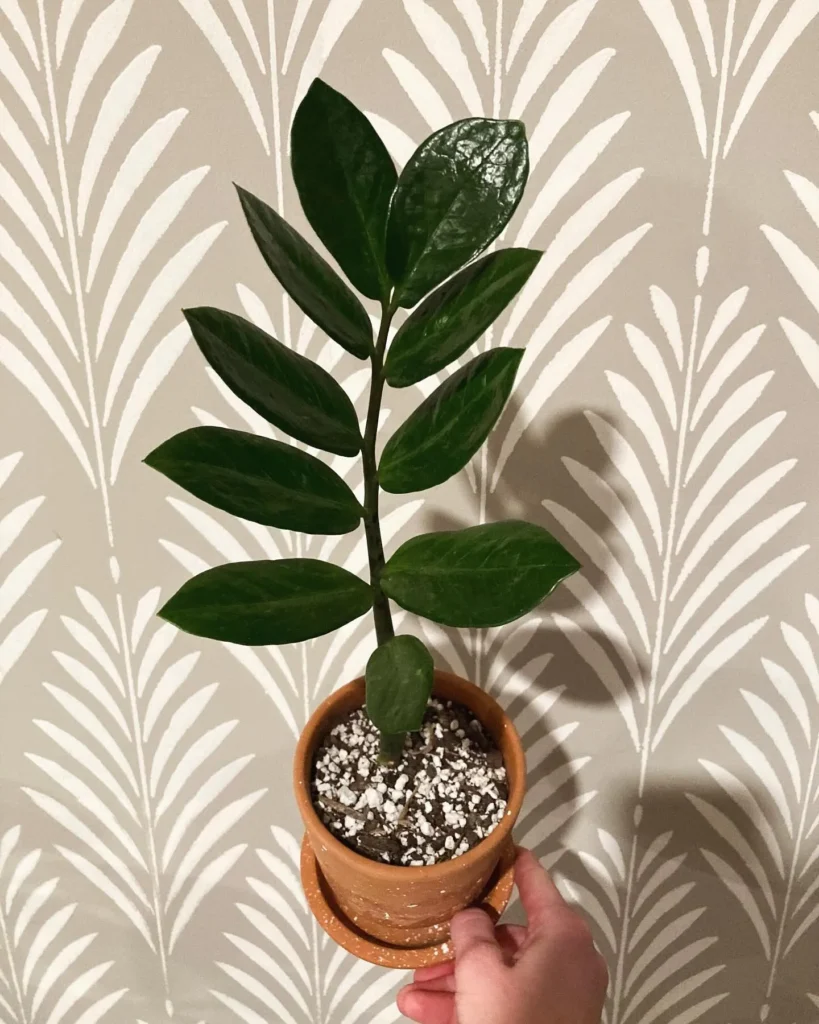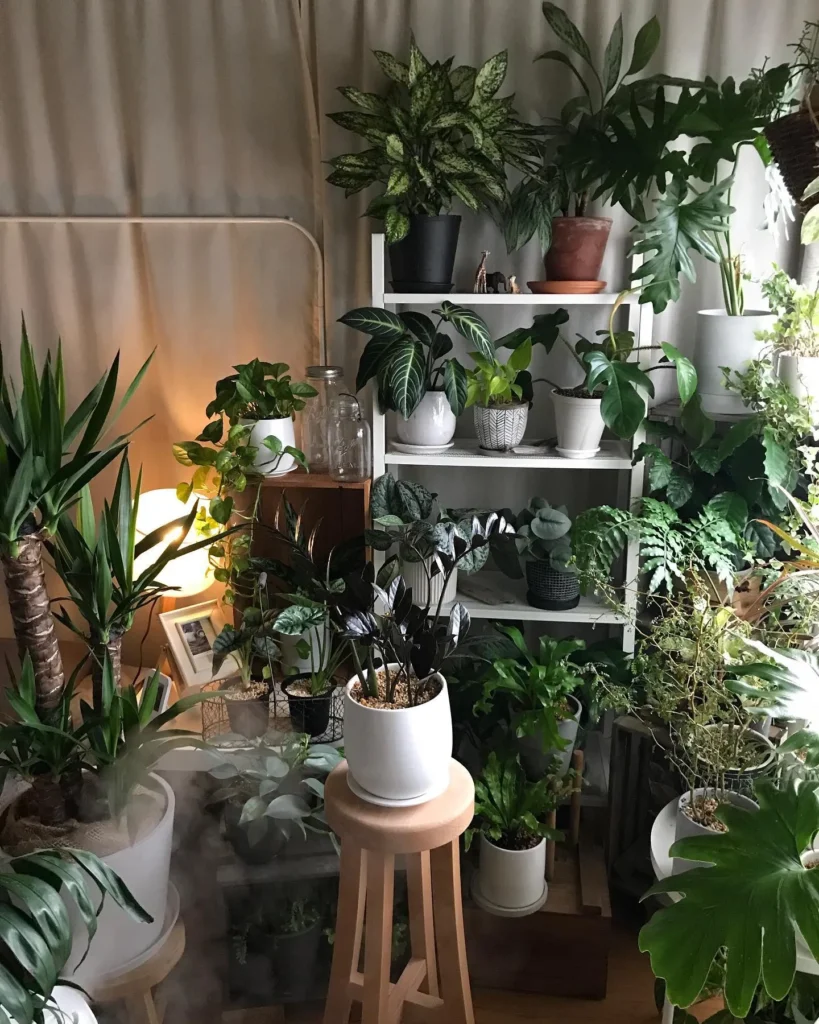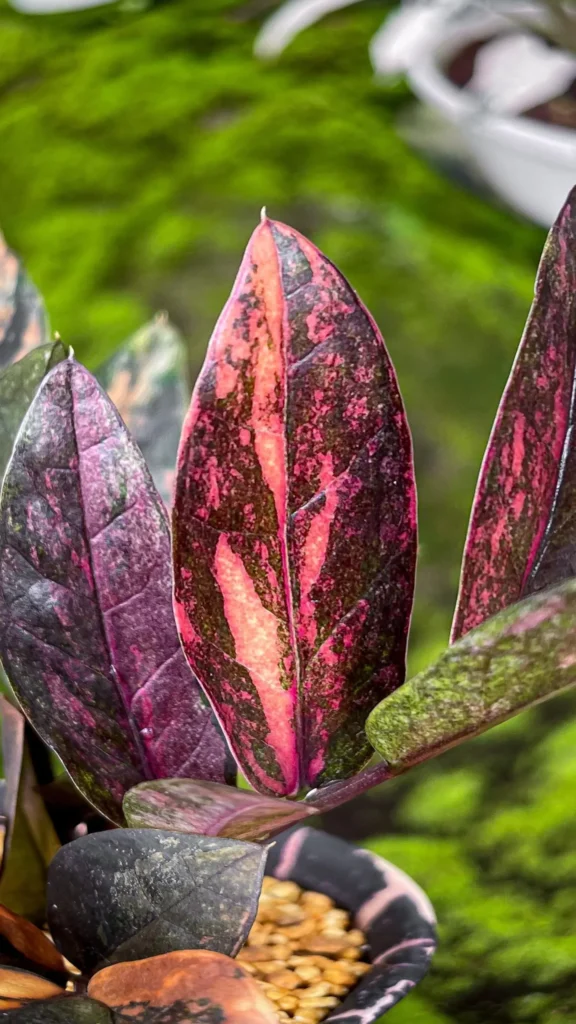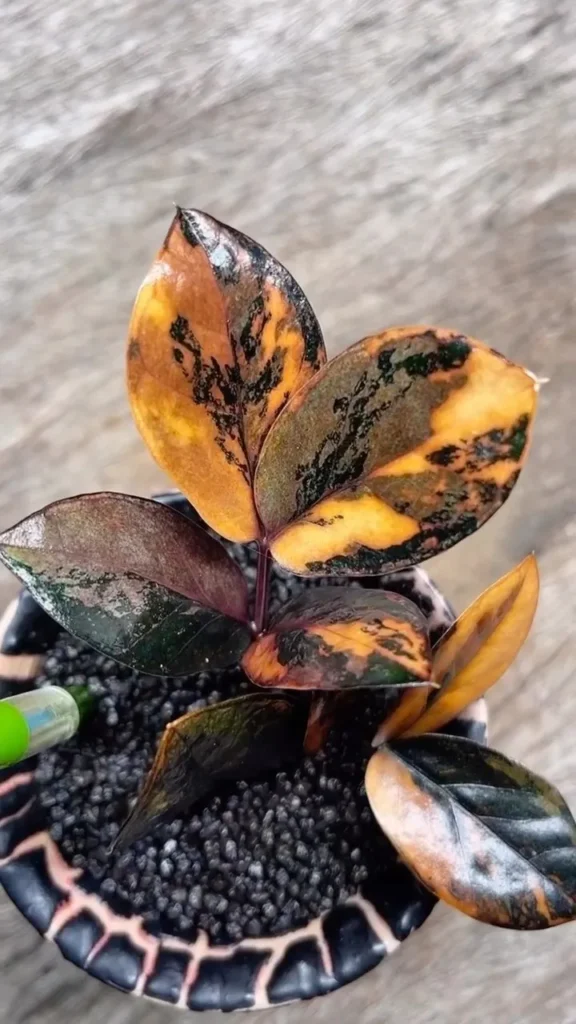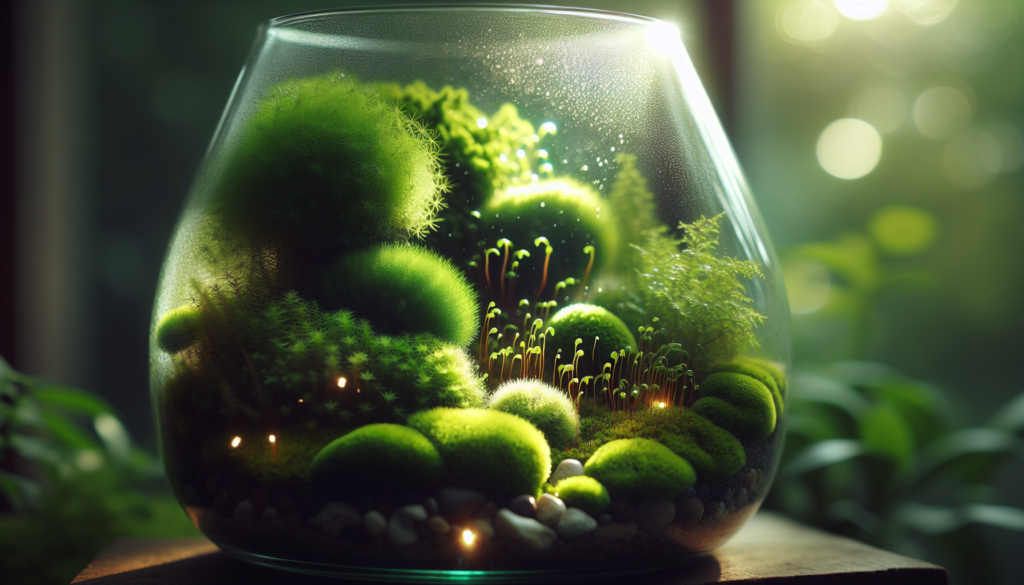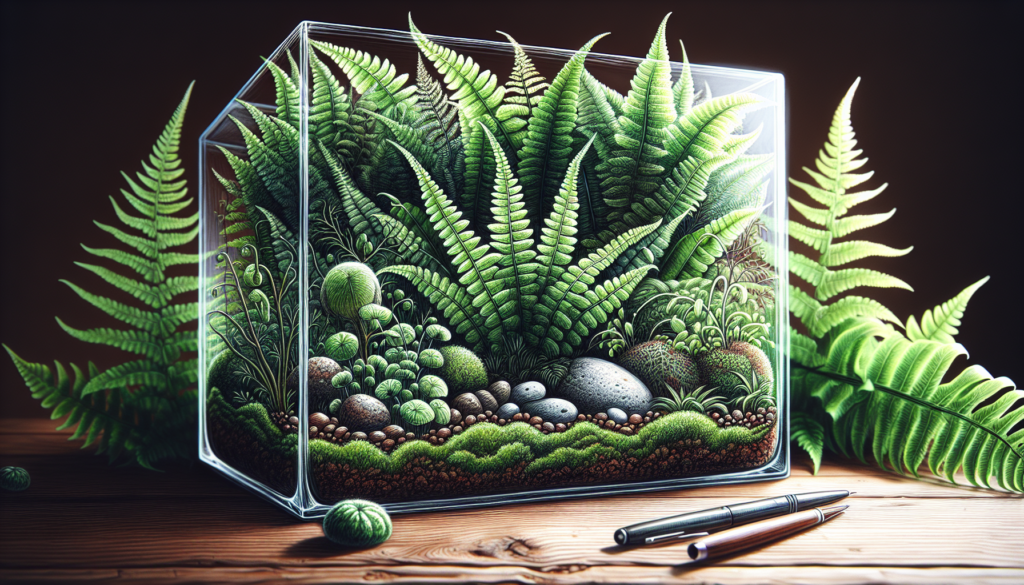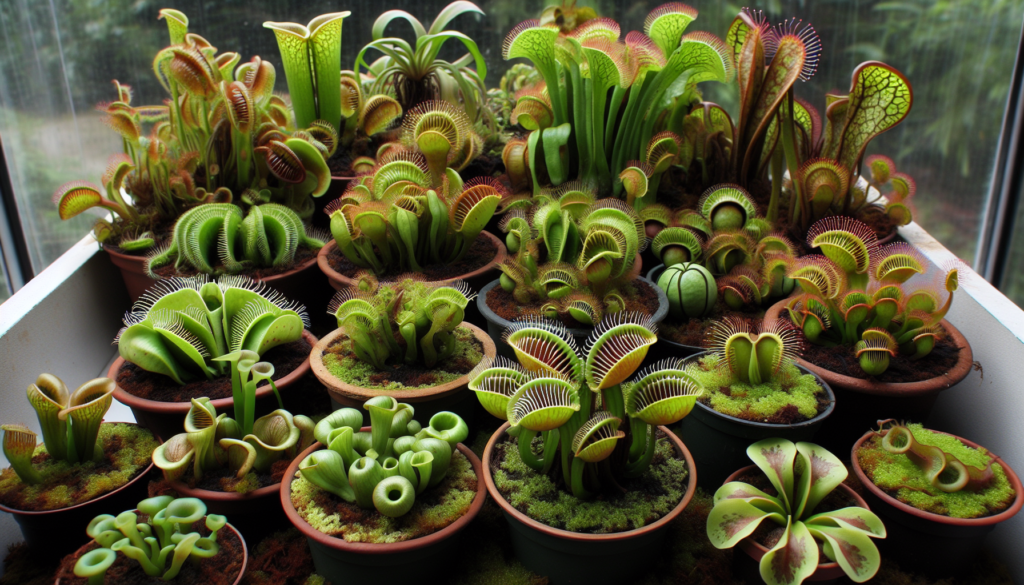The ZZ Plant, scientifically known as Zamioculcas zamiifolia, showcases a unique and appealing appearance that makes it a popular choice for indoor gardening enthusiasts.
This tropical perennial features smooth, shiny, and oval-shaped leaflets that range in color from bright lime to deep emerald green. The leaflets typically measure one to three inches in length and grow on thick stalks, adding to the plant’s robust and sturdy appearance.
Appearance of ZZ Plant
What sets the ZZ Plant apart is its large rhizomes, which are concealed beneath the soil. These rhizomes serve as water reservoirs, allowing the plant to withstand periods of drought. They play a crucial role in the ZZ Plant’s ability to thrive in various conditions, making it a hardy and resilient addition to your indoor plant collection.
In terms of size, the ZZ Plant can reach a height and width of two to three feet, though it can take around three to five years for it to reach its maximum potential. The slow growth rate of the ZZ Plant is influenced by factors such as light, temperature, and overall care. However, some ZZ Plants may exhibit faster growth and gain six inches or more per season, depending on the favorable conditions provided.
Light Requirements for ZZ Plant

The ZZ Plant has specific light requirements to thrive indoors. It prefers medium to bright indirect light, making it a versatile choice for various indoor environments. However, it can tolerate lower indirect light conditions as well, making it a low-maintenance option.
To ensure optimal growth, the ZZ Plant requires a minimum of six hours of light per day. During warmer months, it can handle up to 12 hours of light. However, it is important to keep the plant away from intense, direct sunlight, as it can lead to leaf burn.
An ideal location for your ZZ Plant is in a bright spot with indirect light in a room that has south-facing windows. This will provide the plant with the right amount of light without exposing it to excessive sunlight.
Watering ZZ Plant
Watering Frequency
The ZZ Plant should be watered every 2-3 weeks, allowing the soil to dry out between waterings. However, it’s important to note that the watering frequency may vary depending on the light conditions.
In brighter light, the plant may need more frequent watering, while lower light conditions require less water. So, be sure to adjust the watering schedule accordingly to provide the optimal moisture levels for your ZZ Plant.
Signs of Thirst
How do you know when your ZZ Plant is thirsty? Look out for these signs:
- Wilting leaves: When the plant lacks water, the leaves may start to droop or wilt.
- Wrinkled leaves: If the leaves appear wrinkled or dehydrated, it’s a sign that the plant needs water.
- Dry potting mix: Test the soil by inserting your finger about an inch deep. If it feels dry, it’s time to water your ZZ Plant.
Signs of Overwatering
Overwatering can be detrimental to the ZZ Plant’s health. Here are some signs that indicate your plant is receiving too much water:
- Wet soil: If the soil feels consistently damp or wet, it’s a sign of overwatering.
- Yellowing and mushy leaves: Overwatered ZZ Plants may develop yellowing leaves that feel soft and mushy to the touch.
Fertilizing ZZ Plant
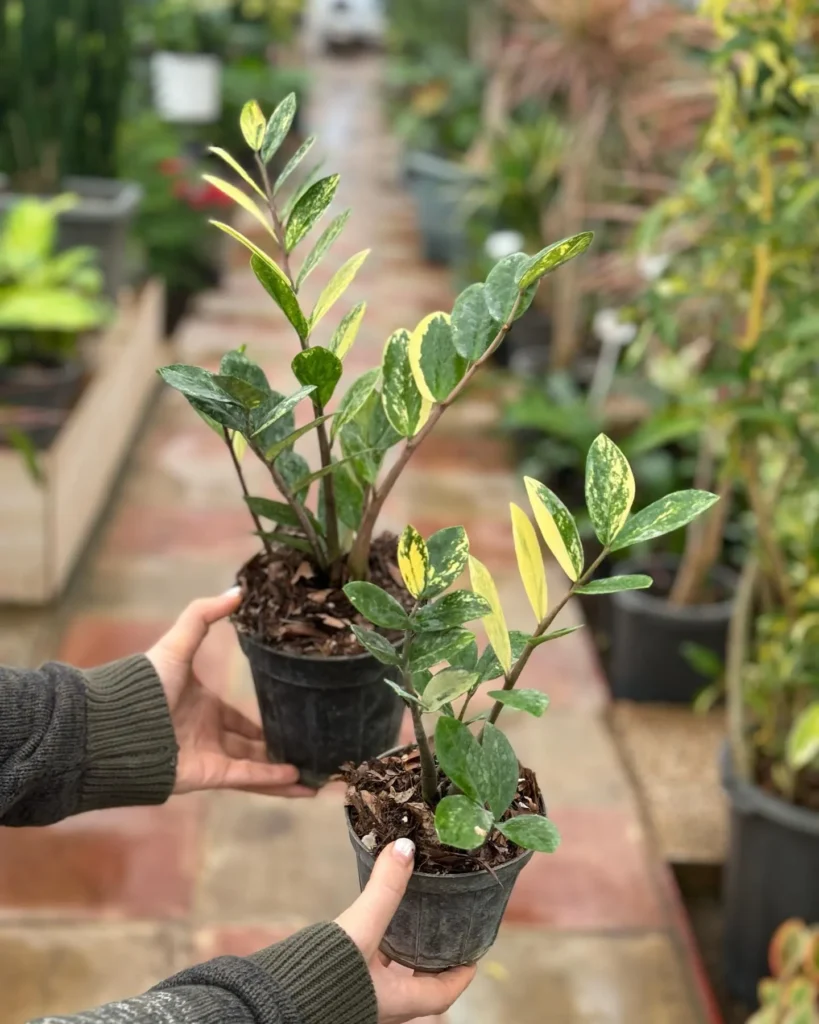
ZZ Plants are known for their low-maintenance nature and can thrive without regular fertilizing. However, providing additional nutrients through fertilization can promote growth and overall plant health. Here are some tips for fertilizing your ZZ Plant:
1. Frequency
While ZZ Plants do not require frequent fertilizing, you can consider fertilizing every six months or even monthly during the growing season. This can provide the necessary nutrients for optimal development.
2. Type of Fertilizer
Use indoor plant fertilizers that are specifically formulated for houseplants. Dilute the fertilizer to half-strength to avoid over-fertilization, which can harm the plant. This gentle approach ensures that the ZZ Plant receives the necessary nutrients without being overwhelmed.
3. Application
Apply the diluted fertilizer to the soil around the base of the ZZ Plant. Avoid direct contact with the plant’s foliage as this can cause fertilizer burn. Gently water the plant after fertilizing to allow the nutrients to penetrate the soil.
4. Nutrient Requirements
ZZ Plants have moderate nutrient requirements. Look for fertilizers that provide a balanced blend of essential nutrients, such as nitrogen (N), phosphorus (P), and potassium (K). These nutrients support healthy growth and overall plant vigor.
- Nitrogen (N) promotes leaf and stem growth.
- Phosphorus (P) supports root development and flowering.
- Potassium (K) enhances overall plant health, including disease resistance.
Potting ZZ Plant
When it comes to potting your ZZ Plant, choosing the right potting mix is essential. ZZ Plants thrive in well-draining mixes that allow excess moisture to escape. Most standard potting mixes are suitable for ZZ Plants, but if you want to improve drainage and aeration, consider adding perlite or lava rocks to the mix. These additives help create air pockets and facilitate better root growth.
When selecting a pot for your ZZ Plant, opt for a container with drainage holes. This allows excess water to flow out, preventing waterlogging and potential root rot. It’s important to choose a pot that provides ample room for the ZZ Plant’s rhizomes and allows for growth. As the plant grows, you may need to repot it into a larger container to accommodate its size.
Propagation of ZZ Plant

If you want to expand your ZZ Plant collection or share this beautiful plant with friends, there are two primary methods of propagation: division and stem cuttings. Both methods are relatively straightforward and yield successful results.
Division
Propagation through division involves separating the rhizomes of the ZZ Plant. When you’re repotting your ZZ Plant, carefully remove it from its pot and gently separate the clumps of rhizomes into individual sections. Ensure that each section has a healthy amount of rhizome and several leaflets.
Then, plant each separated section into its own container filled with well-draining potting mix. Provide the newly potted divisions with proper care, and they will start growing into independent plants. This method is an easy and efficient way to create more ZZ Plants.
Stem Cuttings
Another method of propagating ZZ Plants is through stem cuttings. To propagate using stem cuttings, start by selecting a healthy and mature stalk with multiple leaflets.
Carefully cut the chosen stalk just below a node, ensuring that the cutting is around 4-6 inches long. Remove the bottom leaves of the cutting, leaving a stem with a few leaflets at the top.
Place the cutting in a glass of water, making sure that the nodes are submerged. Keep the glass in a bright but indirect light location. After a few weeks, the cutting will develop roots.
Once the roots are well-established, transplant the cutting into a potting mix, and continue caring for it as you would a mature ZZ Plant. Stem cuttings are an excellent way to propagate ZZ Plants and expand your collection.
Growth and Development of ZZ Plant
The ZZ Plant is known for its slow growth, taking three to five years to reach a height and width of two to three feet. Some plants may experience faster growth, gaining six inches or more per season.
The growth rate of the ZZ Plant can be influenced by various factors, including:
- Light: Providing the plant with medium to bright indirect light can promote healthy growth. However, it can also tolerate lower light conditions.
- Temperature: ZZ Plants prefer temperatures between 65°F-75°F (18°C-24°C). Extreme temperatures may affect their growth.
- Care: Proper care, including regular fertilizing and appropriate watering, can support the growth and development of the ZZ Plant.
Pests and Diseases of ZZ Plant
While ZZ Plants are generally resistant to pests and diseases, it’s important to be aware of common issues that can occur. One common problem is the infestation of houseplant pests such as mealybugs, scale, fungus gnats, and aphids. These pests can cause damage to the leaves and stems of the ZZ Plant.
To combat these pests, you can use insecticidal soap, which is an effective and safe solution for eliminating them. Simply apply the soap according to the instructions on the packaging, making sure to cover all affected areas. Regularly inspecting your ZZ Plant for any signs of pest infestation and taking prompt action can help prevent the spread of pests.
Another common issue that ZZ Plants can face is related to watering. Overwatering or underwatering can lead to problems such as root rot or dehydration. It’s important to monitor the watering needs of your ZZ Plant and provide it with proper care. Allow the soil to dry out between waterings, and ensure that the pot has proper drainage to prevent waterlogging. Remember, when it comes to watering, it’s better to err on the side of underwatering rather than overwatering.
By being proactive and attentive to the needs of your ZZ Plant, you can prevent many common issues from occurring. Regularly inspect the plant for any signs of pests and take immediate action if necessary. Additionally, maintain a proper watering schedule and ensure that the plant is receiving the right amount of light. With the right care, your ZZ Plant will thrive and continue to bring beauty to your indoor space.
FAQ
Q: What is the appearance of a ZZ Plant?
A: The ZZ Plant features shiny, green leaflets that start as bright lime color and mature into emerald green. It grows from thick stalks and has large rhizomes hidden underneath the soil for water storage.
Q: What are the light requirements for a ZZ Plant?
A: The ZZ Plant thrives in medium to bright indirect light. It can tolerate lower indirect light conditions as well. It requires a minimum of six hours of light per day and can handle up to 12 hours during warmer months. However, it should be kept away from intense, direct sunlight to prevent leaf burn.
Q: How often should I water a ZZ Plant?
A: ZZ Plants should be watered every 2-3 weeks, allowing the soil to dry out between waterings. The frequency of watering may vary depending on the light conditions, with more watering needed in brighter light and less in lower light. Signs that the plant needs water include wilting, wrinkled leaves, and dry potting mix. On the other hand, wet soil or yellowing and mushy leaves indicate overwatering and root rot.
Q: How often should I fertilize a ZZ Plant?
A: ZZ Plants are low-maintenance and generally do not require regular fertilizing. However, fertilizing every six months or even monthly during the growing season can provide additional nutrients. Indoor plant fertilizers diluted to half-strength can be used. Fertilizing can help promote growth and overall health of the plant.
Q: What type of potting mix is best for ZZ Plants?
A: ZZ Plants do well in well-draining potting mixes. Most standard potting mixes are suitable, but if additional drainage is needed, adding perlite or lava rocks can help increase aeration. It’s important to choose a pot with drainage holes to prevent waterlogging and potential root rot.
Q: How can I propagate a ZZ Plant?
A: ZZ Plants can be propagated through division and stem cuttings. Division involves separating the rhizomes when repotting and placing them in separate containers. This is a simple way to create more plants. Propagation through stem cuttings involves cutting a stalk with leaflets, removing the bottom leaves, and placing it in water until roots form. Once substantial root growth is achieved, the cutting can be planted in a potting mix.
Q: How long does it take for a ZZ Plant to grow to its full size?
A: ZZ Plants are slow growers and can take three to five years to reach a height and width of two to three feet. Some plants may grow faster and gain six inches or more per season. The growth rate can be influenced by factors such as light, temperature, and overall care. Regular fertilizing and appropriate watering can support growth and development.
Q: What are the common pests and diseases of ZZ Plants?
A: ZZ Plants are generally resistant to pests and diseases. However, common houseplant pests such as mealybugs, scale, fungus gnats, and aphids can infest the plant. Insecticidal soap can be used to eliminate most of these pests. Overwatering or underwatering can lead to issues such as root rot or dehydration. Monitoring the plant’s watering needs and providing proper care can prevent these problems.



